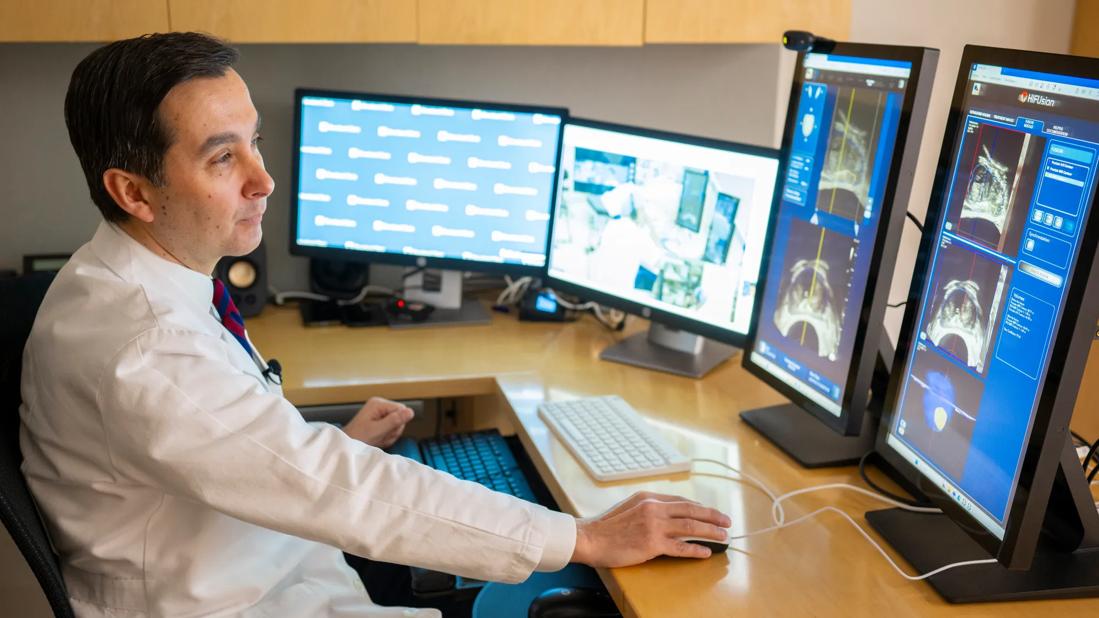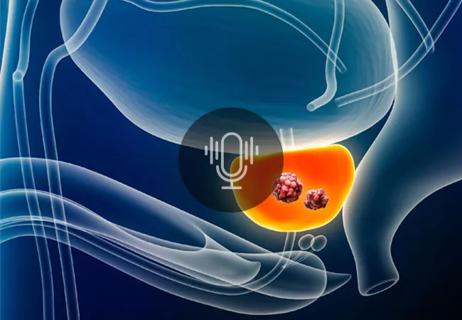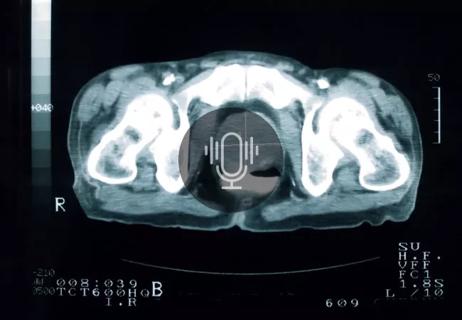Historic collaboration connects two Cleveland Clinic locations, enables real-time sharing of metrics and surgical progress

An older adult patient with grade group 2, intermediate-risk prostate cancer underwent a high-intensity focused ultrasound (HIFU) procedure at Cleveland Clinic Abu Dhabi to treat a solitary lesion on the left side of his prostate.
Advertisement
Cleveland Clinic is a non-profit academic medical center. Advertising on our site helps support our mission. We do not endorse non-Cleveland Clinic products or services. Policy
Under general anesthesia, he woke up from the one-and-a-half-hour procedure, reporting no pain and discomfort. On the surface, it was like any other HIFU procedure performed at Cleveland Clinic—except for one significant detail.
Urologist Ruben Olivares, MD, one of the surgeons participating in the procedure, was more than 7,000 miles (11,412 kilometers) away at Cleveland Clinic Main Campus. Here, he mapped out and was overseeing the surgical dashboard. While Waleed A. Hassen, MD, Department Chair of Urology in the Surgical Subspecialties Institute at Cleveland Clinic Abu Dhabi, managed the on-site surgical execution.
The historic collaboration connected two Cleveland Clinic locations, enabling a real-time sharing of metrics and surgical progress.
Drs. Olivares and Hassen, as well as a dedicated group of engineers and IT teams from both centers, meticulously planned the case and tested the system over a period of a few months to ensure stable and rapid connection. Additionally, the physicians worked closely with cybersecurity teams and navigated legal and ethical frameworks to ensure a secure and reliable process.
Patient safety, procedure quality and oncological efficacy were their primary goals, and the benefits, they say, are many. Telesurgery has the potential to improve issues related to access, offer enhanced training opportunities and build global partnerships.
HIFU has emerged as an attractive option in the urologist’s armamentarium. In select patients with local disease, it can provide an alternative option to a traditional prostate cancer treatment paradigm. Dr. Olivares, one of the most experienced HIFU surgeons in the world, was recruited from Chile in 2022 to lead the focal therapy program at Cleveland Clinic.
Advertisement
In 2023, Dr. Olivares visited Abu Dhabi to help formalize the focal therapy program alongside Dr. Hassen and Georges-Pascal Haber, MD, PhD, CEO of Cleveland Clinic Abu Dhabi. The physicians set out to increase communication and the shared experience between the entities, but their work during this visit ultimately set plans for this case into motion.
“We would discuss whether certain patients were candidates for HIFU,” notes Dr. Olivares, who would offer recommendations based on available MRI imaging and patient history. But the notion of a collaborative, remote treatment became a natural outgrowth of their work together.
While this case is a world-first for focalized treatment, other recent experiences have set a precedent for prostate telesurgery. In 2024, teams out of Beijing and Rome led a successful remote robotic prostate cancer surgery. Another case, this time in a nonhuman model, connected two robots in Orlando to those in Dubai and Shanghai, respectively.
The concept of telesurgery isn’t new. In 2001, surgeons from Mount Sinai Medical Center in New York collaborated with colleagues from Louis Pasteur University in Strasbourg to remove a patient’s gallbladder, making it the first robot-controlled telesurgery made possible with a high-speed fiberoptic connection.
Nearly 25 years of technological advancements—and two years of dedicated planning between the Cleveland Clinic teams—made this case possible. Specifically, Dr. Olivares sites the following:
Improved communication networks: “Landline communication offers high-speed, low-latency and cyber-secure connection. What this means for us is that high-quality connectivity between each other and the robots results in seamless remote operations.”
Advertisement
Technological synergy: “Modern robot platforms can connect and synchronize across continents.”
Global adoption of focal therapy: “Focal therapy has become increasingly popular in Latin America, Asia, and the Middle East. Additionally, Cleveland Clinic’s global presence means we have patients in different regions where we can potentially offer a new service for patients with the right indications.”
Access to minimally invasive therapies like focal therapy varies greatly across states and communities. Dr. Olivares asserts that telesurgery can improve accessibility to advanced, safe and effective treatments worldwide, offering access to under-resourced areas and the expertise of highly trained surgeons.
However, as it’s still relatively new, many residency and fellowship programs in the U.S. have not yet adopted formal focalized treatment training programs. Dr. Olivares has been instrumental in implementing such programs in 13 academic centers in the U.S. in the past decade. He’s confident this uptick will continue, particularly as longer-term data about HIFU become available.
This remote model could open new possibilities for training across regions in the U.S. or globally. “Surgeons new to focal therapy could receive real-time proctoring for their initial cases, fostering confidence and competence,” explains Dr. Olivares.
Cleveland Clinic’s urology leadership is hopeful that this case is the first of many, particularly as medicine moves into a new era of telesurgery.
Jihad Kaouk, MD, Department Chair of Urology at Cleveland Clinic, remarks, “We are witnessing the dawn of telesurgery. As we move forward, we anticipate clearer guidance on how to navigate emerging challenges in this field. Ultimately, telesurgery presents a unique opportunity to expand access to care, enhance training opportunities and improve healthcare access globally."
Advertisement
Advertisement

Approach offers a ‘middle ground’ between radical prostatectomy and active surveillance

AI histologic classifier reliably predicts clinical risk in men post-prostatectomy

Patient factors and cancer characteristics are key to deciding between focal therapies and whole gland treatment

Novel research to evaluate noninvasive treatments in ED and chronic pelvic pain

Correlation found between the biomarker HSD3B1 and resistance to combined hormone therapy and radiotherapy

FDA-approved therapy offers promise for patients with castrate-resistant prostate cancer

Using novel robotic approaches for a difficult-to-access prostate

A newer modality for select patients has shown positive outcomes to date